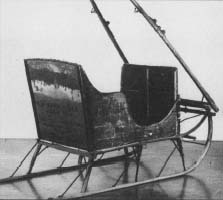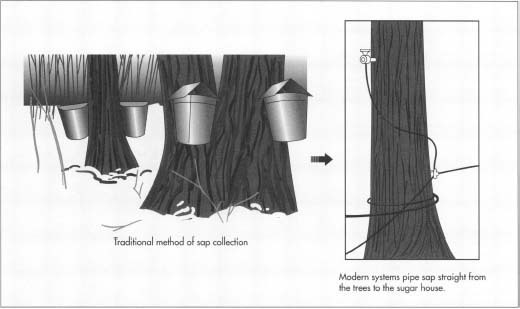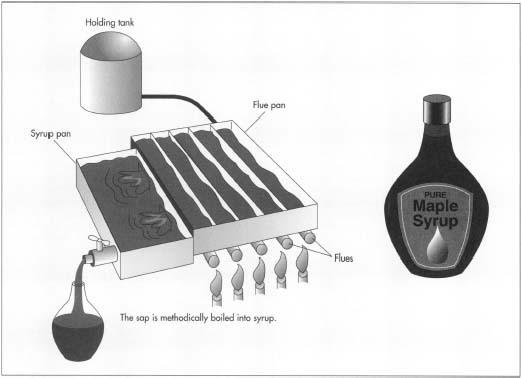Maple Syrup
Background
The Algonquin Indians called it sinzibukwud, meaning drawn from wood. It was the Algonquins and the other Native American tribes of the northeastern United States and southeast Canada who first showed French and British settlers how to draw the sap of Acer saccharum, the sugar maple, and reduce it into a sweet, thick liquid known today as maple syrup.
In early March, when the days started to become warm but nights were still freezing, Native Americans would cut a vee in the trunk of a maple and insert a reed or curved piece of bark into the opening. Under the opening, they would set a larger piece of bark or a clay pot to catch the dripping sap. The sap was concentrated either by leaving it out overnight and then tossing out the water, which had frozen on top, or by placing hot stones into the sap to evaporate some of the water. The resulting product was used in cooking and sometimes as a sweet drink. European settlers introduced iron and copper pots into the process, which allowed the sap to be heated longer, removing more of the water and producing what we know as maple syrup today. Throughout the 1700s, both maple syrup and maple sugar served as an integral unit of trade for the early colonies, but they would soon be supplanted by another sweet crop from warmer climates, namely sugar cane.
Since the sixteenth century, Spain, England, and France had grown profitable sugar cane crops in their Caribbean island colonies. In 1803, the Louisiana Purchase gave U.S. investors direct access to the territory's burgeoning cane sugar industry, which had been developed by French growers fleeing slave revolts in the Caribbean. In 1849, large scale cane cultivation by U.S. growers began in Hawaii. Throughout the 1800s, improvements to production methods, combined with constant pressure from the now-powerful sugar industry for increased tariff protection from the federal government, as well as cane's naturally high yield (one acre of cane will produce 12.5 tons of raw sugar [31 metric tons per ha]) succeeded in making cane sugar the sweetener of choice.
The maple and its syrup remain an integral part of spring in northeastern North America. Many of the towns and villages in the area arrange a yearly festival centered around the maple harvest. The sugar maple is the state tree of New York, Vermont, Wisconsin, and West Virginia. The maple leaf flies at the center of Canada's national flag, which is entirely appropriate since the Canadian province of Quebec is by far the largest producer of syrup in the world. Today, the United States and Canada produce a combined average of a little over five million gal (18,920,0001) of maple syrup annually.
Raw Materials
Of the over 200 different species of tree in the maple family, only a few produce sap of sufficient quality and sugar content to be used for maple syrup. The northeastern section of North America is the only region in the world where the environmental conditions are capable of producing tappable sap that will yield maple syrup, and where one is able to find the sugar maple tree. The sugar, or rock, maple can grow to 130 ft (40 m) with a diameter of 3 ft (1 m). A tree must be at least 12 in (30.5 cm) in diameter before it can be tapped; it will take 40 years to reach that size. The sugar maple is also highly prized for its hard, beautifully grained wood used in furniture making and as a veneer. Some sugar maples form intricate patterns such as bird's eye maple, which has small circles scattered throughout the wood resembling birds' eyes. Other North American native maples, the black, the red, and the silver maple, will also produce syrup. The black maple has a yield close to the sugar and is used alongside it in syrup production. The red and silver are used less often as they generally produce less sugar, have a shorter growing season, and may have sap that is slightly cloudy.
The sap itself is made up of 90% water. The remaining 10% of the sap is a mixture of sugars (mostly levulose, which is a variant of fructose and hexose, which is glucose plus fructose), calcium, potassium, phosphorous, iron, and trace amounts of B vitamins. In order to make the sap into syrup, most of the water will be removed, which is why it takes approximately 40 gal (1511) of sap to make 1 gal (41) of syrup.
The Manufacturing
Process
In the making of maple syrup, one could say that the farmer comes last and not be wrong. The sap of the maple will never become maple syrup until the farmer intercedes. The following five components make up that transformation.
Season
- 1 In the winter, the maple does not grow, and it stores its sap in its roots. By late spring when the trees begin to produce leaves and flowers, a chemical change will have occurred in the sap giving it an unpleasant taste, which farmers describe as "buddy." It is only in early spring, usually February through April, when warm days cause the sap to flow up from the roots to the branches to feed new growth and cold nights cause the sap to return to the roots, that the trees can be tapped.

Americans have always had a sweet tooth. Native Americans satisfied their taste for sugar through the production of maple syrup and European settlers of New England learned the practice. After the Revolutionary War, many farm families in the northern United States and territories produced maple syrup and maple sugar for home consumption. Surveyors of new territories noted the presence of "sugar" trees, and settlers named streams near maple groves "Sugar Creek."
Cane sugar production in America did not develop until the late eighteenth century. The growing season in the southern part of the United States did not allow sugar cane to mature, and no methods of processing immature cane existed. In 1795, in what was then French territory, Etienne de Bore perfected a means of crystallizing sugar from immature sugar cane in New Orleans. Other planters copied de Bore and the American cane sugar industry began. By 1802, 75 sugar plantations produced as much as eight million Ib (four million kg) of brown sugar. When the United States acquired the Louisiana Purchase, it gained these sources of sugar production. Midwestern farmers, and later, Western producers who used irrigation, grew sugar beets to sell to sugar processors.
Sugars from cane and beets are generally used for baking, but maple syrup and maple sugar remain popular in spite of other sweeteners. Families with an affinity for this tasty confection continue to tap trees in the spring, and thousands of Americans purchase maple syrup to pour over their morning stack of pancakes.
Leo Landis
Tapping
-
2 To tap a maple tree, farmers drill a 0.5 in (1.3 cm) hole about 2.5-3
in (6-8 cm)
into the trunk. The hole is drilled at a slightly upward angle to prevent sap from collecting in the hole, freezing, and cracking the trunk. Care is taken only to drill into the light-colored sapwood, which will heal, and not into the darker heartwood, which will not. Trees from 12-15 in (30.5-38 cm) in diameter supports one tap, and the number of taps increases as the trees grow larger, with a maximum of four taps per tree. Each tap yields an average of 10 gal (38 1) of sap per season, which makes about a quart of syrup. New holes must be drilled at least 4 in (10 cm) above and 6 in (15 cm) to either side of previous holes. This prevents large areas of scar tissue from forming in the wood and leaving the tree open to disease. Properly cared for, the holes will heal completely in one or two years and will cause no damage to the tree.
 To collect maple sap, holes are drilled into the trees and hollow spikes are inserted. Traditionally, pails collected the syrup that dripped out, but modern systems send the sap directly to the sugar house.
To collect maple sap, holes are drilled into the trees and hollow spikes are inserted. Traditionally, pails collected the syrup that dripped out, but modern systems send the sap directly to the sugar house.
Collecting
-
3 Once the tree is tapped, farmers gently drive a hollow spike called a spile into the hole. The spile is a round, hollow piece of wood about the diameter of a broom handle with a metal tip to help drive the end into the wood. Traditional methods use a canvas bag or a bucket hung from the spile to catch the dripping sap. The bucket or bag is covered to keep out debris. Once a day, the farmer empties the buckets into a large gathering tank pulled through the fields by a horse or tractor. The tank is pulled to the building where the sap is processed, called the sugar house, and emptied into a holding tank.
While the sight of pails hung from maples and the sound of dripping sap is much more romantic than modern systems, this traditional method of collection has a few inherent flaws, especially for large-scale producers. The first is that collecting syrup bucket by bucket is both time and labor intensive, and is therefore costly. The second is that sap should be processed immediately after being collected in order to produce the best quality syrup. Under the traditional system, if collection exceeds production, the sap must be stored. And if collection falls behind, production must slow.
Modern systems eliminate the collection process altogether and send sap straight from the trees to the sugar house. To accomplish this, a plastic tube is attached to each spile; the tubes run together to a larger pipe, and the pipes, in turn, run from the
various parts of the orchard directly to the sugar house. A pump maintains a constant, slight vacuum and keeps the sap constantly moving through the pipeline. Collected sap enters the holding tank and then travels to the flue pan. Here it is heated, concentrating the sap and causing a chemical change. Maple sap becomes maple syrup at the moment when its concentration of sugar reaches 66%. The syrup is filtered and poured into containers.
Collected sap enters the holding tank and then travels to the flue pan. Here it is heated, concentrating the sap and causing a chemical change. Maple sap becomes maple syrup at the moment when its concentration of sugar reaches 66%. The syrup is filtered and poured into containers.
Sugaring
-
4 Possibly the most important piece of the maple syrup-making process takes place in the sugar house. The initial sugar content of the sap, its clarity, and to some extent, its taste are all determined by weather, soil, and ultimately, the tree, all of which are outside the control of the grower. It is only through the process of heating and condensing the sap that it takes on the distinctive sweet flavor of maple syrup.
Most commercial syrup producers use a continuous feed system to make syrup. Sap continuously, but very slowly, enters from a holding tank on one end, and finished syrup is continuously drained and bottled at the other end. The sap is heated over a wood- or oil-fueled fire in a series of long, shallow stainless steel pans. This causes the water in the sap to steam off, condensing the sap, and causes a chemical change in the sap, which brings out a flavor not present before it is heated. The sap first enters the flue pan, which has a corrugated bottom lined with a series of pipes called flues. The flues serve two purposes. First, the fire heats the air inside the flues, which provides a more even, gentle heat than the fire gives directly and which allows the sap to be heated longer and at a higher temperature, evaporating more water without the danger of scorching the sap. Second, the wavy pan bottom increases the surface area of the pan and allows more syrup to be in contact with the heat at the same time. From the flue pan, the sap flows into the flat-bottomed syrup pan where it is finished. The two pans are divided by partitions that allow a slow, constant flow of sap.
Maple sap becomes maple syrup at the moment when its concentration of sugar reaches 66%. Producers test this concentration using two methods. The first uses the formula that syrup is finished when it reaches the temperature at which water boils plus 7.1°F (4.3°C). Because water boils at different temperatures depending on altitude, producers boil a sample of water and measure its temperature. When the syrup reaches the sample's temperature plus 7.1°F (4.3°C), it is done. The second, perhaps more scientific, method involves an instrument called a hydrometer. A hydrometer is a sealed glass tube with a small amount of weight in one end. Running horizontally around the outside of the tube are a series of lines which indicate concentration in percentage; the lines are specially calibrated for maple syrup. Once the sap has been heated, a sample is placed in a cylinder and the hydrometer is placed in the sap. The hydrometer sinks to the line that indicates the current sugar concentration in the sap. When the hydrometer sinks to the line that indicates 66%, the sap has become syrup. As the sugar approaches 66%, it is checked constantly. Finishing the syrup at the proper sugar concentration is critical: too high and the syrup will crystallize; too low and it will spoil.
Bottling
- 5 Once the syrup is properly finished, it is poured through a cloth filter to remove any sugar sand, called nitre. It is then poured into glass or metal containers while still hot. The container is filled to the very top and then tightly sealed. Because maple syrup contains no preservatives, this final step ensures that the container is sterile and airtight and prevents any spoiling.
Quality Control
In order to be considered pure maple syrup, a product must be 100% pure. Products containing other ingredients are labelled table or pancake syrup. The grades listed on the bottle have nothing to do with purity or sweetness (all maple syrup has the same sugar concentration) or even necessarily with quality or taste. The grades are based solely on the syrup's ability to transmit light. The more light that can shine through the syrup, the higher the grade. This system can be used because the opacity of syrup relates directly to the way it tastes. Connoisseurs will say that syrups from different regions have distinctive tastes, but generally, the more opaque the syrup, the heavier the maple taste will be. The United States Department of Agriculture assigns grades A through C to syrup, with A being the lightest. Within each grade are three further divisions for color, light, medium, and dark amber. Grade A dark amber is the most commonly used for table syrup. It has a pleasant, full-bodied maple taste. Grade A light amber is considered the finest syrup. Its taste is very delicate and subtle. Occasionally, growers will produce syrup graded extra fancy, which is even subtler than grade A light amber. Grade B syrup has a much richer, more "mapley" taste; it is primarily used in cooking. Grade C has a strong, thick taste and is used almost exclusively as a commercial sweetener.
Where to Learn More
Books
Gemming, Elizabeth. Maple Harvest: The Story of Maple Sugaring. Coward, McCann, & Geoghehan, 1976.
Muir, Reginald. The Vermont Maple Syrup Cook Book. Phoenix Publishing, 1974.
Nearing, Helen. The Maple Sugar Book. Schocken Books, 1970.
Periodicals
Berk, Gesina. "Sugaring Time - How Maple Sugar is Made." Humpty Dumpty's Magazine, March 1996, pp. 16-20.
Clark, Edie. "Sap Bucket Blues." Yankee, March 1996, p. 18.
Martin, Rux. "Caught up in the Romance of Maple." Yankee, March 1994, pp. 132-139.
Robinshaw, Sue. "Spring in the Sugarbush." Countryside & Small Stock Journal, March-April 1993, pp. 63-66.
Other
"Camp 100 % Pure Maple Syrup, the Maple Syrup Experts!" http://www.ivic.qc.ca/abri-web/erable/faq_32.html#anchor709074 (March 29, 1997).
Heiligmann, Randall B. "Hobby Maple Syrup Production." http://www.ag.ohiostate.edu/~ohioline/forestry/f-36.html (January 16, 1997).
"Maple Syrup-A Sweet Natural Resource." http://monsterbit.com/touch/maple1.html (January 16, 1997).
"The Story of Maple Syrup." http://www.state.vt.us/agric/minfo.htm (January 16, 1997).
"What is Maple Syrup?" March 5, 1996. http://www.mkl.com/~jmitchell/maple/syrup.html#whatis (March 29, 1997).
— Michael Cavette
Comment about this article, ask questions, or add new information about this topic: